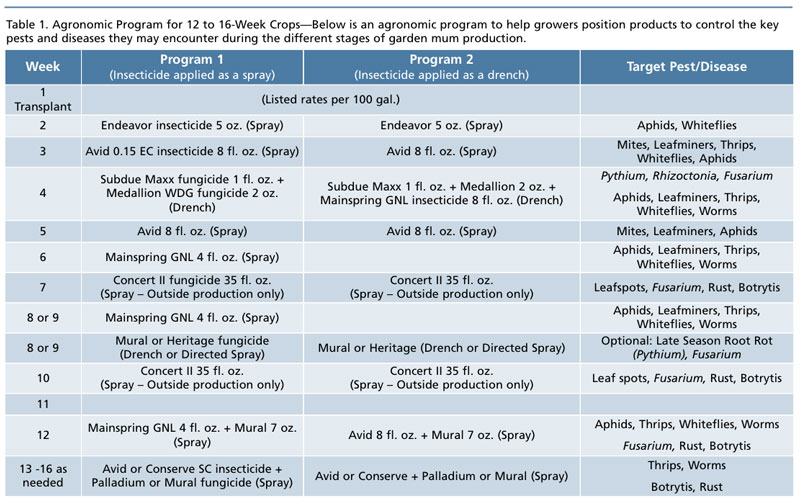8/1/2020
It’s Time to Fall for Mums
Nancy Rechcigl
The production of garden mums during the summer months is not without some challenges. A large percentage of mums are produced outside where they’re subject to varying weather conditions, along with some insect and disease pressure. Being prepared for the potential challenges ahead can help avoid losses and ensure plant quality for successful fall sales.
Common pests
In all stages of production, garden mums are highly susceptible to aphids, thrips, mites and worms. Aphids have a fast development time, especially in the warmer months, which means populations can grow quickly. They can be found feeding in groups on new growth, stems, buds and even on lower leaves. Aphids feed by piercing plant parts to extract fluids and can also damage crops by excreting honeydew (a shiny, sticky substance that attracts the growth of sooty mold). In addition, aphids can spread chrysanthemum Virus B, so early detection and control is key.
While thrips are primarily a concern once a crop is in flower, injury to foliage can occur earlier in production. Thrips’ rasping mouth parts scrape plant tissue and feed on the sap, which results in leaf stippling, scarring and distortion. They can also be a vector for Impatiens Necrotic Spot Virus and Tomato Spotted Wilt Virus, two serious viruses that can spread rapidly throughout the mums and other crops in the area.
Two-spotted spider mites (TSSM) can periodically be a problem in garden mums. They can quietly invade the crop and build up quickly with the warm summer temperatures. Mites tend to hide down in the canopy during the heat of the day, so be sure to scout lower foliage carefully and regularly. Controlling a mite infestation once the plant has attained some size can be a formidable task since spray coverage and penetration into the canopy is difficult.
Loopers, armyworms and other lepidopteran pests also like to feed on mums and can do quite a bit of damage if they aren’t found in time. Be observant for moth activity in the production area so appropriate controls can be applied to “nip them in the bud” before they get a chance to “nip off” some terminals.

Common mum diseases
The primary disease problems encountered during garden mum production are root rots caused by Pythium spp. and Fusarium wilt, caused by Fusarium oxysporum. As a plant group, chrysanthemums are quite resilient; however, outdoor production during the summer months can be stressful on the plants. High temperatures and direct sun on the container can raise soil temperatures and cause stress to the root system. Periodic rain events can sometimes cause the media to become over-saturated, reducing pore space and limiting oxygen for the roots. This drying and wetting of the media can cause injury to the roots, allowing an entryway for these pathogens.
Pythium spp. infections occur more commonly in southern regions, especially in areas that experience frequent, heavy rain events and hot temperatures. Growing media that contains high soluble salts can also lead to root burn and make plants more susceptible to attack. Infected plants will be lighter green in color, smaller in size and wilt during the heat of the day, even when the soil is moist. As the disease progresses, lower leaves will turn yellow and drop from the plant. This pathogen can spread to adjacent plants through water movement, so it’s important to elevate pots in low areas of the field where water may pool.
Symptoms of Fusarium infections often show in late summer, but infections begin earlier, so it’s important to have crops protected throughout the season. Fusarium wilt occurs more frequently when plants are stressed, therefore it’s important to pay close attention to the proper growing practices and environmental conditions. When infections take place, the pathogen typically invades one side of the vascular system, which results in signs of one-sided wilt. Infections will also make foliage in sections of the canopy appear lighter in color and cause wilting from the bottom up.
In the northern regions of the country and areas with cooler climates, rust diseases are also of serious concern and must be prevented with a rotation of appropriate fungicides.
Garden mums agronomic approach
Preparation is an essential part of every greenhouse and nursery operation. An agronomic program is a strategy to manage the production of a crop. Implement-ing appropriate cultural practices (regularly monitoring pH, soluble salt levels, moisture and root health), and scouting to identify insect and disease problems early are two critical parts of an agronomic program. The third part entails having a plant protection program that provides preventive and curative control measures for the targeted problems that can impact your crop. Utilizing an agronomic program can prevent and/or limit insect and disease outbreaks, ensure crop quality and lead to a successful growing season.
How to establish a program
An agronomic program can provide a framework for product rotations to address the most common pest and disease problems your crop is likely to encounter. An important feature of an agronomic program is that it contains a built-in resistance management strategy that incorporates a rotation of multiple products with different modes of action for control of the problem targets. A well-structured rotation program will consider how best to utilize the products’ strengths and leverage modes of action at times when they’ll provide the maximum benefit. Activity of the product, current environmental conditions, lifecycle of pests and level of pressure will determine the frequency in which each product should be applied to crops.
While every greenhouse and nursery operation are different, one consistent factor common to all is that preparation is key to success. Growing mums for fall sales means having to deal with the challenges summer production can bring. By planning ahead with an agronomic program, growers are prepared when the expected and unexpected arise.
For more information about agronomic programs, visit GreenCastOnline.com/Solutions. GT

Nancy Rechcigl is a technical services manager for ornamentals for Syngenta.